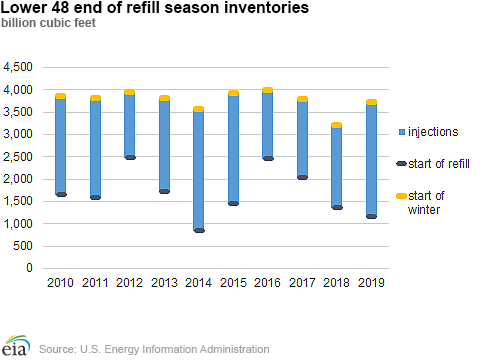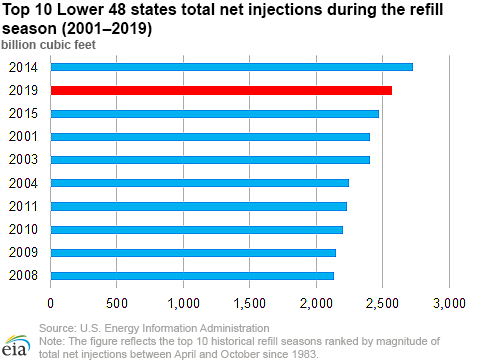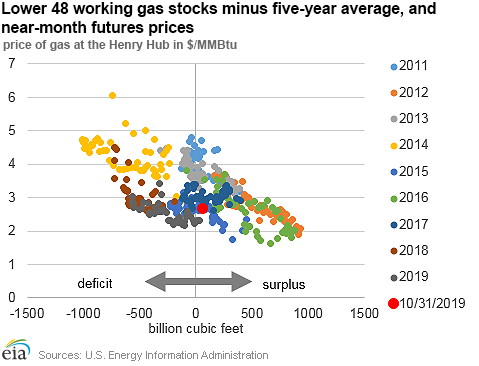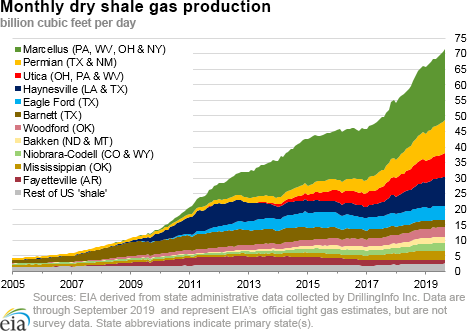In the News:
Net injections post second-largest refill season on record; working gas stocks end refill season higher than the five-year average
Near-record injection activity during the 2019 natural gas refill season (April 1–October 31) resulted in a rapid recovery of working gas stocks from their relatively low level at the end of the 2018–19 heating season. Working natural gas in storage in the Lower 48 states as of October 31 totaled 3,724 billion cubic feet (Bcf), according to interpolated data from EIA’s Weekly Natural Gas Storage Report released November 7. Total inventory as of October 31 was 37 Bcf higher than the five-year (2014–18) end-of-October average and 527 Bcf (16%) higher than last year at this time. Although the end of the natural gas storage injection season is traditionally defined as October 31, injections often occur in November.
A low starting inventory level has historically preceded strong refill seasons, and 2019 followed this pattern. Working natural gas stocks ended the withdrawal season this year on March 31 at 1,155 Bcf—the second-lowest level reported since 2004. From April 1 through October 31, 2019, EIA estimates that net injections totaled 2,569 Bcf. Net injections were 678 Bcf (36%) higher than the five-year average and 732 Bcf (40%) higher than net injections last year. This level was the second-highest net injected volume for the refill season ever reported, falling just short of the record level of 2,727 Bcf injected during the 2014 refill season. In 2014, working gas stocks ended the winter at 837 Bcf—the lowest level since 2003—and ended the refill season at 3,564 Bcf.
Continued strength in natural gas production during 2019 accounted for the large increase in natural gas storage volumes during 2019 despite increases in natural gas demand, which were primarily driven by natural gas-fired power generation increases, greater pipeline exports to Mexico, and growing liquefied natural gas (LNG) exports. The larger injections into working gas storage reduced the deficit to the five-year average, which exceeded 500 Bcf entering the refill season, and resulted in working gas inventories exceeding the five-year average on October 11—the first time since 2017.
The working gas difference to the five-year average tends to be negatively correlated with the Nymex near-month natural gas futures settlement price. Stocks that are high compared with the five-year average often correlate with lower natural gas futures prices. Conversely, stocks that are low compared with the five-year average usually correspond to higher natural gas futures prices.
This relationship is visualized as a scatterplot with natural gas futures prices on the y-axis and the level of stocks compared with the five-year average on the x-axis. Each dot represents a week, and the dots are color-coded to reflect different years. Pricing patterns have varied somewhat during 2019. Earlier this year, larger storage deficits, which exceeded 250 Bcf, were associated with futures prices ranging between $2.50 per million British thermal units (MMBtu) and $3.41/MMBtu. As the deficit to the five-year average diminished during the course of the refill season, prices eased somewhat, and the futures contract for next-month delivery at the Henry Hub generally traded lower than $2.50/MMBtu. Early season cold weather increased futures prices somewhat in recent weeks.
Overview:
(For the week ending Wednesday, November 6, 2019)
- Natural gas spot prices rose at most locations this report week (Wednesday, October 30 to Wednesday, November 6). The Henry Hub spot price rose from $2.67/MMBtu last Wednesday to $2.78/MMBtu yesterday.
- At the New York Mercantile Exchange (Nymex), the price of the December 2019 contract increased 14¢, from $2.691/MMBtu last Wednesday to $2.828/MMBtu yesterday. The price of the 12-month strip averaging December 2019 through November 2020 futures contracts climbed 7¢/MMBtu to $2.567/MMBtu.
- Net injections to working gas totaled 34 Bcf for the week ending November 1. Working natural gas stocks are 3,729 Bcf, which is 17% more than the year-ago level and 1% more than the five-year (2014–18) average for this week.
- The natural gas plant liquids composite price at Mont Belvieu, Texas, rose by 36¢/MMBtu, averaging $5.65/MMBtu for the week ending November 6. The price of propane, ethane, butane, and isobutane rose by 10%, 9%, 9%, and 6%, respectively. The price of natural gasoline remained flat week over week.
- According to Baker Hughes, for the week ending Tuesday, October 29, the natural gas rig count decreased by 3 to 130. The number of oil-directed rigs fell by 5 to 691. The total rig count decreased by 8, and it now stands at 822.
Prices/Supply/Demand:
Prices rise at most trading hubs. This report week (Wednesday, October 30 to Wednesday, November 6), the Henry Hub spot price rose 11¢ from $2.67/MMBtu last Wednesday to a high of $2.78/MMBtu yesterday. Temperatures were generally cooler than normal across the Lower 48 states. At the Chicago Citygate, the price increased 29¢ from $2.69/MMBtu last Wednesday to a high of $2.98/MMBtu yesterday.
Northeast prices increase with growing heating demand. At the Algonquin Citygate, which serves Boston-area consumers, the price went up $1.18 from $1.90/MMBtu last Wednesday to a high of $3.08/MMBtu yesterday. At the Transcontinental Pipeline Zone 6 trading point for New York City, the price increased 83¢ from $1.87/MMBtu last Wednesday to a high of $2.70/MMBtu yesterday. Although temperatures were generally normal in the Northeast, average minimum temperatures were at or below freezing in the region, increasing weather-driven demand for natural gas.
The Tennessee Zone 4 Marcellus spot price increased 67¢ from $1.75/MMBtu last Wednesday to $2.42/MMBtu yesterday. The price at Dominion South in southwest Pennsylvania rose 67¢ from $1.79/MMBtu last Wednesday to $2.46/MMBtu yesterday.
California prices are mixed. Temperatures were slightly warmer than normal across the state. The price at PG&E Citygate in Northern California traded within a relatively narrow range and rose 4¢, up from $3.40/MMBtu last Wednesday to $3.44/MMBtu yesterday. The price at SoCal Citygate in Southern California decreased 25¢ from $3.73/MMBtu last Wednesday to $3.48/MMBtu yesterday.
The Permian Basin price declines, widening the discount to the Henry Hub price. The price at the Waha Hub in West Texas, which is located near Permian Basin production activities, averaged $1.88/MMBtu last Wednesday, 79¢/MMBtu lower than the Henry Hub price. Yesterday, the price at the Waha Hub averaged 99¢/MMBtu, $1.79/MMBtu lower than the Henry Hub price. The Waha price reached a low of 84¢/MMBtu on Monday.
Supply is flat. According to data from IHS Markit, the average total supply of natural gas remained the same as in the previous report week, averaging 99.5 Bcf/d. Dry natural gas production remained constant week over week. Average net imports from Canada increased by 3% from last week.
Demand rises sharply in residential and commercial sectors and falls across all other sectors. Total U.S. consumption of natural gas rose by 8% compared with the previous report week, according to data from IHS Markit. In the residential and commercial sectors, consumption increased by 40% as generally cooler temperatures prompted widespread demand for space heating for this first time this season in the Lower 48 states. Natural gas consumed for power generation declined by 4% week over week. Industrial sector consumption decreased by 3% week over week. Natural gas exports to Mexico decreased 1%.
U.S. LNG exports decrease week over week. Twelve LNG vessels (six from Sabine Pass, two from Corpus Christi, two from Cove Point, and one each from Cameron and Freeport) with a combined LNG-carrying capacity of 43 Bcf departed the United States between October 31 and November 6, according to shipping data compiled by Bloomberg. One vessel was loading at the Sabine Pass terminal on Wednesday.
On November 4, the 1000th LNG export cargo was shipped from the United States since the start of LNG exports from the Lower 48 states in February 2016. An estimated 3.42 trillion cubic feet of natural gas have been exported as LNG from the United States between February 2016 and November 6, 2019.
Storage:
Net injections into storage totaled 34 Bcf for the week ending November 1, compared with the five-year (2014–18) average net injections of 57 Bcf and last year's net injections of 63 Bcf during the same week. Working gas stocks totaled 3,729 Bcf, which is 29 Bcf more than the five-year average and 530 Bcf more than last year at this time.
According to The Desk survey of natural gas analysts, estimates of the weekly net change from working natural gas stocks ranged from net injections of 31 Bcf to 57 Bcf, with a median estimate of 43 Bcf.
More storage data and analysis can be found on the Natural Gas Storage Dashboard and the Weekly Natural Gas Storage Report.
See also:
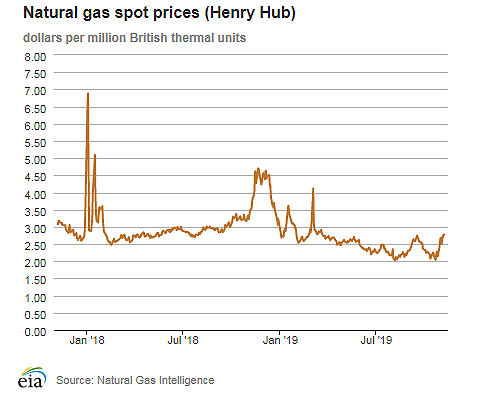
| Spot Prices ($/MMBtu) | Thu, 31-Oct |
Fri, 01-Nov |
Mon, 04-Nov |
Tue, 05-Nov |
Wed, 06-Nov |
|---|---|---|---|---|---|
| Henry Hub |
2.68 |
2.50 |
2.74 |
2.77 |
2.78 |
| New York |
1.89 |
1.98 |
1.84 |
2.41 |
2.70 |
| Chicago |
2.57 |
2.28 |
2.69 |
2.79 |
2.98 |
| Cal. Comp. Avg.* |
2.87 |
2.70 |
2.93 |
3.05 |
3.04 |
| Futures ($/MMBtu) | |||||
| December contract | 2.633 |
2.714 |
2.821 |
2.862 |
2.828 |
| January contract |
2.732 |
2.802 |
2.898 |
2.940 |
2.907 |
| *Avg. of NGI's reported prices for: Malin, PG&E Citygate, and Southern California Border Avg. | |||||
| Source: NGI's Daily Gas Price Index | |||||
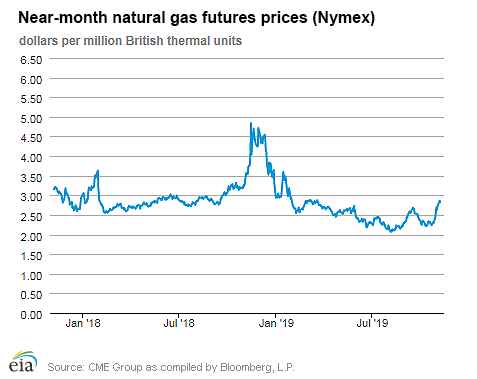
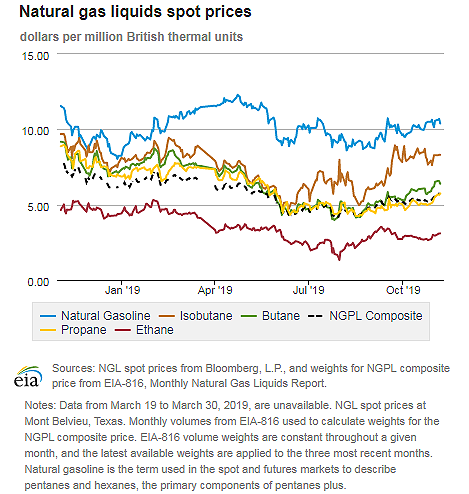
| U.S. natural gas supply - Gas Week: (10/31/19 - 11/6/19) | |||
|---|---|---|---|
Average daily values (Bcf/d): |
|||
this week |
last week |
last year |
|
| Marketed production | 107.4 |
107.5 |
99.2 |
| Dry production | 94.9 |
94.8 |
88.0 |
| Net Canada imports | 4.5 |
4.4 |
3.6 |
| LNG pipeline deliveries | 0.1 |
0.1 |
0.1 |
| Total supply | 99.5 |
99.2 |
91.7 |
|
Source: IHS Markit | |||
| U.S. natural gas consumption - Gas Week: (10/31/19 - 11/6/19) | |||
|---|---|---|---|
Average daily values (Bcf/d): |
|||
this week |
last week |
last year |
|
| U.S. consumption | 74.1 |
68.3 |
69.5 |
| Power | 26.2 |
27.4 |
23.1 |
| Industrial | 21.3 |
22.0 |
23.7 |
| Residential/commercial | 26.6 |
19.0 |
22.6 |
| Mexico exports | 5.2 |
5.3 |
4.6 |
| Pipeline fuel use/losses | 6.7 |
6.6 |
6.3 |
| LNG pipeline receipts | 7.3 |
7.1 |
4.0 |
| Total demand | 93.4 |
87.3 |
84.4 |
|
Source: IHS Markit | |||
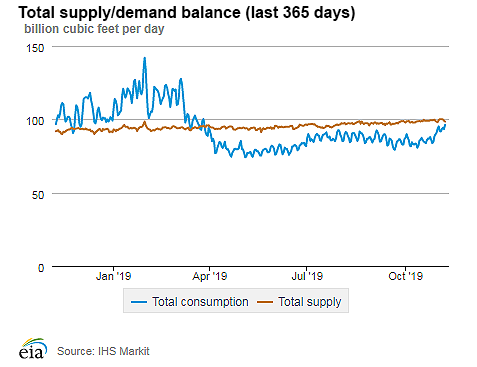
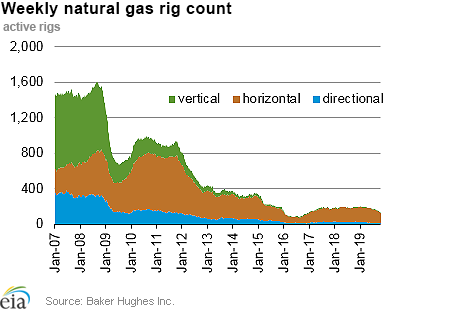
| Rigs | |||
|---|---|---|---|
Tue, October 29, 2019 |
Change from |
||
last week |
last year |
||
| Oil rigs | 691 |
-0.7% |
-20.9% |
| Natural gas rigs | 130 |
-2.3% |
-32.6% |
| Note: Excludes any miscellaneous rigs | |||
| Rig numbers by type | |||
|---|---|---|---|
Tue, October 29, 2019 |
Change from |
||
last week |
last year |
||
| Vertical | 0 |
0.0% |
0.0% |
| Horizontal | 12 |
9.1% |
-62.5% |
| Directional | 53 |
3.9% |
-27.4% |
| Source: Baker Hughes Inc. | |||
| Working gas in underground storage | ||||
|---|---|---|---|---|
Stocks billion cubic feet (Bcf) |
||||
| Region | 2019-11-01 |
2019-10-25 |
change |
|
| East | 932 |
913 |
19 |
|
| Midwest | 1,109 |
1,095 |
14 |
|
| Mountain | 207 |
211 |
-4 |
|
| Pacific | 292 |
298 |
-6 |
|
| South Central | 1,189 |
1,178 |
11 |
|
| Total | 3,729 |
3,695 |
34 |
|
|
Source: Form EIA-912, Weekly Underground Natural Gas Storage Report | ||||
| Working gas in underground storage | |||||
|---|---|---|---|---|---|
Historical comparisons |
|||||
Year ago (11/1/18) |
5-year average (2014-2018) |
||||
| Region | Stocks (Bcf) |
% change |
Stocks (Bcf) |
% change |
|
| East | 830 |
12.3 |
903 |
3.2 |
|
| Midwest | 977 |
13.5 |
1,076 |
3.1 |
|
| Mountain | 182 |
13.7 |
213 |
-2.8 |
|
| Pacific | 265 |
10.2 |
327 |
-10.7 |
|
| South Central | 945 |
25.8 |
1,182 |
0.6 |
|
| Total | 3,199 |
16.6 |
3,700 |
0.8 |
|
| Source: Form EIA-912, Weekly Underground Natural Gas Storage Report | |||||
| Temperature – heating & cooling degree days (week ending Oct 31) | ||||||||
|---|---|---|---|---|---|---|---|---|
HDD deviation from: |
CDD deviation from: |
|||||||
| Region | HDD Current |
normal |
last year |
CDD Current |
normal |
last year |
||
| New England | 83 |
-43 |
-73 |
0 |
0 |
0 |
||
| Middle Atlantic | 63 |
-53 |
-74 |
0 |
0 |
0 |
||
| E N Central | 135 |
7 |
4 |
0 |
-1 |
0 |
||
| W N Central | 196 |
64 |
85 |
0 |
-1 |
0 |
||
| South Atlantic | 26 |
-44 |
-57 |
42 |
24 |
27 |
||
| E S Central | 46 |
-24 |
-19 |
4 |
1 |
2 |
||
| W S Central | 77 |
41 |
55 |
4 |
-13 |
-21 |
||
| Mountain | 192 |
70 |
104 |
3 |
-2 |
-6 |
||
| Pacific | 60 |
7 |
38 |
7 |
4 |
2 |
||
| United States | 98 |
2 |
8 |
10 |
4 |
3 |
||
|
Note: HDD = heating degree day; CDD = cooling degree day Source: National Oceanic and Atmospheric Administration | ||||||||
Average temperature (°F)
7-day mean ending Oct 31, 2019
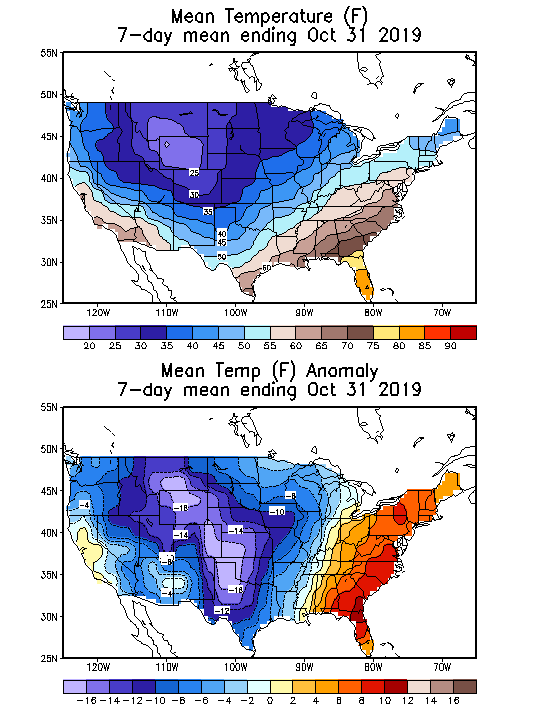
Source: National Oceanic and Atmospheric Administration
Deviation between average and normal (°F)
7-day mean ending Oct 31, 2019

Source: National Oceanic and Atmospheric Administration

